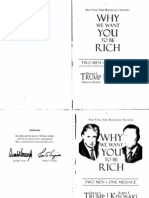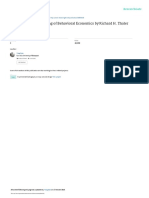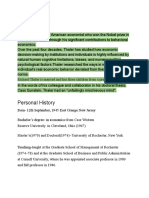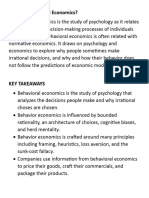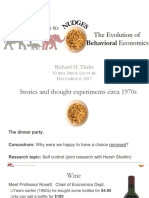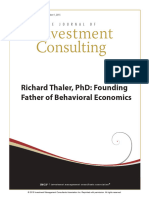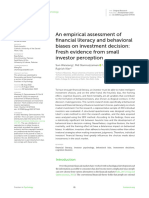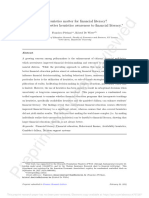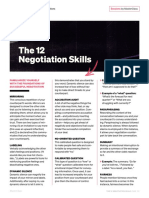Summary of “Misbehaving” by
Richard Thaler
The making of behavioral economics
Written by Bookey
��About the book
In this book, misbehaving refers to the behaviors
that contradict the basic assumptions of traditional
economics. These are often the research subjects of
behavioral economics. Traditional economics
assumes that people are rational and that they make
decisions that benefit themselves the most. To
behavioral economists, however, such assumptions
ignore the irrational side of people. This book
reviews how behavioral economics has developed
throughout the years, and also introduces some
important research findings in the field of study.
�About the author
Richard Thaler is one of the pioneers in the field of
behavioral economics. He was awarded the Nobel
Memorial Prize in Economic Sciences in 2017 for
his contributions to the field. In addition to
Misbehaving: The Making of Behavioral
Economics, he’s also written The Winner’s Curse:
Paradoxes and Anomalies of Economic Life and
Nudge: Improving Decisions About Health, Wealth,
and Happiness, another best-selling book
co-authored by Cass Sunstein. Currently, Thaler
teaches at the University of Chicago Booth School
of Business as a professor of Behavioral Sciences
and Economics. He is also a board member of the
school’s Center for Decision Research.
�Chapter 1: Overview
Hi, welcome to Bookey. Today we’ll unlock the
book Misbehaving: The Making of Behavioral
Economics. What is misbehaving? Let's start with
a two question survey. Question one: Imagine
there is a deadly disease spreading around the
world. Those who contract the disease typically die
within a week, and there is a one in ten thousand
chance that you might get infected. If there is a
medicine that can reduce your infection risk to zero,
how much would you be willing to pay for it?
Question two: Now, your boss wants to send you to
the infected regions for investigations. Your chance
of contracting the deadly disease is still one in ten
thousand. How much would your boss have to pay
in order for you to agree to the assignment?
People that took the survey had very different
answers to the two questions. For the first question,
the respondents were willing to spend very little
money on a life-saving medicine. For the second
question, however, they demanded huge
compensation for such work. From the eyes of
�traditional economics, the core of these two
questions is the same––both are asking people how
much it is worth to take on a one-in-ten-thousand
chance of death. Nevertheless, the answers turn out
to be very different. This can be identified as
misbehaving. In this book, misbehaving refers to
the behaviors that contradict the basic assumptions
of traditional economics. These misbehaviors are
often the research subjects of behavioral economics.
In the past, traditional economists assumed that
people are rational and that they make decisions
that benefit themselves the most. But behavioral
economists believe that this assumption is
fundamentally flawed. If economists try to study
market behavior or make economic forecasts based
on such assumptions, the results would be flawed
as well. People in real life are not always rational.
In fact, they often make decisions that seem quite
the opposite. Behavioral economists believe that in
order to have a more accurate understanding of
human behavior, they need to take the irrational
side of people into account as well. This book
�reviews how behavioral economics has developed
throughout the years, while introducing some of the
important research findings in the field of study.
Through this book, you’ll have a comprehensive
understanding of the interesting field of behavioral
economics. The author, Richard Thaler, is one of
the pioneers in the field of behavioral economics.
He was awarded the Nobel Memorial Prize in
Economic Sciences in 2017 for his contributions to
the field. In addition to this book, he’s also written
“The Winner’s Curse: Paradoxes and Anomalies of
Economic Life and Nudge: Improving Decisions
About Health, Wealth, and Happiness, another
best-selling book co-authored by Cass Sunstein.
This book is available on Bookey as well. Currently,
Thaler teaches at the University of Chicago Booth
School of Business as a professor of Behavioral
Sciences and Economics. He is also a board
member of the school’s Center for Decision
Research and serves as co-director of the
Behavioral Economics Project at the National
Bureau of Economic Research. In this bookey,
�we’ll learn about behavioral economics in three
parts. Part One: How misbehaving leads to the
birth of behavioral economics; Part Two: Basic
theories of behavioral economics; Part Three:
How behavioral economics helps us make better
decisions. Let’s go through them one by one.
�Chapter 2: How misbehaving leads
to the birth of behavioral
economics
When Thaler first became a teacher, he was not
liked by his students. It’s not because his classes
were not good, but due to how his exams were
designed. In order to group the students into
different levels, some of the exam questions were
very difficult so only the top students knew the
answer. The scores varied greatly as a result, and
the average was just 72 points. It’s not hard to
imagine why the students hated Thaler and his
exams. Although Thaler wanted to be liked by his
students, he did not want to make the exam any
easier. What should he do? Finally, he raised the
total score from 100 to 137 for the next exam, and
not surprisingly, the average score of the class also
improved from 72 to 96 points. Although their
percentage score did not change, the students were
much happier. In the eyes of traditional economists,
the students’ behavior was very unusual. 96 points
�out of 137 and 72 points out of 100 should make no
difference, but clearly, that’s not how the students
felt. Thaler noticed many similar examples of
this, so he made a list of all of the behaviors that
seem irrational. For example, Thaler and his friend
Jeffrey bought two tickets for a basketball game.
On the day of the game, there was a huge blizzard
and the game was an hour and a half drive away.
Thaler thought they should just stay home, but
Jeffrey felt that since he had already bought the
expensive tickets they should go and watch the
game no matter what. According to traditional
economics, the money spent on the tickets is the
sunk cost, that is the effort or capital that has
already been spent and cannot be recovered.
Theoretically, a rational person should ignore the
sunk cost and it shouldn’t affect their decision
about whether or not to watch the game. But
obviously, in real life, people often don’t act in the
ways economists expect. In another example
Thaler’s friend Linnea was shopping for a clock
radio. She found a model that she liked for $45,
�which to her is a reasonable price. As she was
about to buy it, the clerk mentions that the same
radio is on sale for $35 at a grand opening sale of a
new branch of the store, ten minutes away. Without
hesitation, Linnea went to the other branch for the
radio. A few days later, Linnea was shopping for a
television set and found one for $495. Again, the
clerk tells her that the same model is on sale at
another branch ten minutes away for $485. But this
time, Linnea chose to stay where she was and
bought the television right there. Linnea's behavior
shows that she values her time differently
depending on the situation. In both cases, she could
have saved an additional $10 by spending another
ten minutes on the way, but she made different
decisions. Behaviors, or misbehaviors, like these
are very intriguing for Thaler. Why can’t they be
explained by traditional economics? The problem
lies in the most basic assumption of traditional
economics, that people are always rational. We’ve
talked about this briefly in the opening, now let’s
get into the details. Simply put, traditional
�economics assumes that all the participants of in
economics are completely rational people. They
know exactly what they want and how to maximize
their personal benefits. If given $100 to shop at a
supermarket, the rational person can always find
the product combination that’s most satisfactory for
them. They will always follow the principle of
optimizing when making choices. What’s more,
when making decisions, the rational person is never
prejudiced, impulsive, or overconfident. In other
words, they’ll never act in an irrational way. But
Thaler believes this assumption is flawed. For him,
it’s almost impossible for people to be completely
rational in real life. In the example of Linnea, she
could save the same $10 in both cases, but when
$10 accounts for a much smaller percentage of the
product’s total price, she doesn’t think it’s worth
the hassle. It’s even harder to achieve the
so-called optimization principle. When someone is
shopping in the supermarket with a budget, there
are so many things to choose from that nobody can
guarantee that their choice is the best. If this is the
�case for shopping the principle is even more true
for other more difficult choices in life, such as
choosing a career and marriage. Two other
economists were already skeptical about the
principles of traditional economics. They are
Thaler’s lifelong research partners Daniel
Kahneman and Amos Tversky. If you are interested
in their stories, check out the bookeys of Thinking,
Fast and Slow and The Undoing Project: A
Friendship That Changed Our Minds to learn more.
Kahneman and Tversky have written a paper to
show that it’s difficult for ordinary people to be
completely rational. Due to the limited time and
mental capacity, most people make judgments
based on their experience rather than rational
thinking. That’s when they are prone to making
mistakes. For example, if someone asks you if
“Dhruv” is a common name, how would you
answer? You’d probably try to think if you know
anyone with this name. If you're from India,
because many people there are called “Dhruv”, you
might think it's a common name. But if you're not
�from India, you might say it’s not that common. In
fact, this name is quite common globally. But if
you only make judgment based on your own
experience, you might get it wrong. Kahneman
and Tversky have also proposed the prospect
theory to challenge the principles of traditional
economics. To understand it, let’s look at two
interesting experiments. In experiment one, you are
given $300 and then have to choose between the
following two options. Option one, you are
guaranteed to get another $100. Option two, there
is a 50% chance of getting $200 and 50% chance of
getting nothing. In experiment two, you are given
$500 and again have to choose between the two
options. Option one, you’re guaranteed to lose
$100. Option two, there is a 50% chance of losing
$200, but 50% chance of losing nothing. It’s not
difficult to figure out that option one in both
experiments should have the same results. You will
get $400. Similarly, option two in both experiments
are also the same. Both have a 50% chance of
getting $500 and 50% chance of getting $300. If
�people are rational their choices in these two
experiments should be the same. But the actual
results were surprising. In experiment one, 72% of
the respondents chose option one and 28% took
option two. In experiment two, however, only 36%
of the respondents chose option one, and 64% went
with option two. Why was the difference so drastic?
The difference lies in the attitudes people tend to
have toward different types of risks. When it comes
to gains, they often prefer certainty and are more
averse to risks. When it comes to losses, however,
people hate certainty and tend to take on bigger
risks for a chance of losing less. This is the main
idea of the prospect theory. You can find more
details about it in the bookey for The Undoing
Project: A Friendship That Changed Our Minds,
which contains many other interesting theories
from Kahneman and Tversky. Prospect theory
intrigued Thaler’ and he decided to devote himself
to the study of behavioral economics. But the
emerging field was not accepted by traditional
economists. Although traditional economists admit
�that nobody in real life can make completely
rational economic decisions, they insist that people
can improve their decision-making abilities and
approach true rationality through repeated learning
and practice. Traditional economists also believe
that if a decision has high stakes, people would be
more motivated to think carefully, collect
information, and make rational decisions.
According to Thaler, traditional economists’
arguments don’t really hold up. If repeated learning
and practice could help improve decision-making
capabilities, then people shouldn't be making any
irrational decisions when buying things like food
and clothing. People make these kinds of choices
all the days. If people are more careful when
making big decisions with high stakes, they should
act rationally when buying expensive products like
cars, real estate, and financial products, or when
they choose a career or spouse. But in real life, that
doesn’t seem to be the case. This concludes the
content of part one. We’ve learned why traditional
economics is flawed and how to explain some
�customer misbehaviors. We’ve also learned how
Kahneman and Tversky’s research has inspired
Thaler, and the doubts concerning behavioral
economics posed by traditional economists.
�Unlock Full Content in Bookey



























